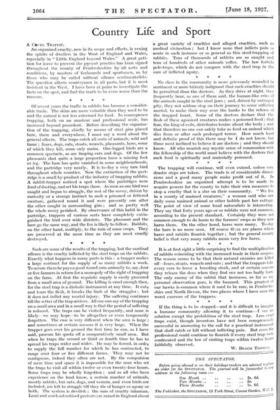Of recent years the traffic in rabbits has become a
consider- able trade. The skim are more valuable than they used to be, and the animal is not less esteemed for food. In consequence trapping, both on an amateur and professional scale, has increased beyond precedent. Before describing the organiza- tion of the trapping, chiefly by means of steel gins placed here, there and everywhere, I must say a word about the general effects. The traps catch all sorts of animals, wild and tame ; foxes, dogs, cats, stoats, weasels, pheasants, hens, some of which they kill, some only maim. One-legged birds are a common spectacle, as arc limping cats and dogs. Of the few pheasants shot quite a large proportion have a missing foot or leg. The hare has quite vanished in some neighbourhoods, and the partridge very nearly. It is to-day a very rare bird throughout whole counties. Now the extinction of the part- ridge is a small by-product of the industry of trapping rabbits. A rabbit-trapper noticed a spot where the partridges were fond of dusting, and set his traps there. As soon as one bird was caught and began to struggle, the rest of the covey, driven by curiosity or a strange instinct to mob a prisoned or fettered creature, gathered round it and were presently one after the other caught in surrounding gins ; and so pretty well the whole covey perished. By observance of this habit in the partridge, trappers of various sorts have completely extin- guished the bird over wide districts. The pheasant and the hare go the same way, and the fox is likely to follow. Rabbits, on the other hand, multiply, to the ruin of some crops. They are preserved at the same time as they are most cruelly destroyed.
• • • •


























































 Previous page
Previous page